As you may notice below – half of these power foods are from animals.
I absolutely love plants and about 60-75% of my diet is composed of things which grow out of the earth. And yet, many the foods which I can attribute my greatest health wins to….. of which I can wholeheartedly say changed my life and consistently contribute to my strength and sanity ……. Come from animals.
1. Bone Broth
Bone broth is seriously a gift from the healing Gods and not sure what my health would be like today had I not been introduced to this vital nutrient source. It’s been used in traditional cultures and in Chinese medicine for thousands of years and is one of the easiest ways to dose our bodies with bio-available minerals – just source your bones from healthy animals!
Here’s a list of some fundamental nutrients in bone broth:
Glycosaminoglycans (GAG):
Glycosaminoglycans have the primary role of maintaining and supporting collagen and elastin that take up the spaces between bones and various fibers. GAGs are supportive for digestive health since they help restore the intestinal lining, which is why a deficiency in these nutrients has been linked to digestive challenges. Several important GAGs are found in bone broth, including glucosamine, hyaluronic acid and chondroitin sulfate.
Minerals and Electrolytes:
Bone broth provides essential minerals, including electrolytes, all provided in an easy-to-absorb form, including calcium, magnesium and potassium (not to mention many other minerals, such as phosphorus), which are important for supporting healthy circulation, bone density, nerve signaling functions, heart health and digestive health. When added sodium levels are kept low, bone broth contains an ideal balance of sodium and potassium to support cellular health and efficiency.
Collagen:
Collagen is the main structural protein found within the human body that helps form connective tissue and “seals” the protective lining of the gastrointestinal tract. It’s also the gel-like, smooth structure that covers and holds our bones together, allowing us to glide and move freely.
Gelatin: (the breakdown of collagen) was one of the first functional foods used as a medical treatment in ancient China.
Here are some benefits of consuming animal gelatin:
- Helps people with food allergies and sensitivities tolerate those foods, including cow’s milk and gluten.
- Protects and soothes the lining of the digestive tract and can aid in healing IBS, Crohn’s, ulcerative colitis and acid reflux symptoms.
- Promotes probiotic balance and growth.
- Bone broth increases collagen, reducing the appearance of wrinkles and banishing cellulite,
tightening your skin, making you look younger
Here’s a list of these amino acids and what they do for us:
Arginine
Necessary for immune system function and wound healing
Needed for the production and release of growth hormone
Helps regenerate damaged liver cells
Needed for the production of sperm
Glycine
Prevents breakdown of protein tissue like muscle
Used to make bile salts and glutathione
Helps detoxify the body of chemicals and acts as antioxidant (18)
Is a neurotransmitter that improves sleep and improves memory and performance
Proline
Helps regenerate cartilage and heal joints
Reduces cellulite and makes skin more supple
Helps repair leaky gut
Glutamine
Protects gut lining
Metabolic fuel for cells in small intestine
Improves metabolism and muscle building
I tend to make big batches of it in my crock pot. chicken bones are often more expensive, so I tend to make beef broth. Beef broth is more nutrient-dense, yet chicken broth definitely smells better while it’s simmering! Your call on which you make. My strategy is much simpler than others, as over the years, I’ve used A LOT of broth in cooking and healing. Afterwards you’ll have possession of some of the world’s most potent medicine!
2. Collagen protein powder
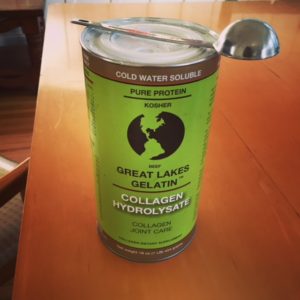
Over the years, I’ve tried just about every damn form of protein powder in the book – both vegan and animal sourced.
Unfortunately most of them work poorly with my digestion and energy needs. Even the most seemingly benign protein like sprouted brown rice powder would often leave me feeling bloated and sluggish – with clear blood-sugar spikes.
This was a big challenge, as pulling myself out of hypoglycemic hell involved eating a lot more small meals throughout the day in order to build my glycogen stores back up and start producing insulin receptors again. I needed protein in these small meals to keep my blood-glucose stable, but felt at a loss as to which proteins to use.
At first – fairly new to animal consumption after 5 years – I naively assumed I could just eat small amounts of meat six times a day. But this was super hard on my digestion. My digestion and detox channels never got a break, so I began to feel toxic.
Next I tried egg white protein powder, but my body didn’t like egg white. Six years later, I still only eat the yolks. I now use small amounts of high-quality whey protein for the glutathione benefits, yet this isn’t any everyday thing. So what the fuck to do?
This is where hydrolyzed collagen protein saved my life. It contains pure protein composed of all amino acids which don’t trigger inflammatory reactions. It’s made of the parts of an animal we used to eat before muscle meat was all the rage, therefore it’s utilizing parts of an animal which would otherwise go to waste or be fed to dogs. It’s proven through multiple studies to be utilized in our own bodies in the way which we would utilize collagen produced by our own bodies. It has no flavor or smell and mixes into liquids and solids at any temperature. I put it in my smoothies, shakes, soups, coffee, and occasional sweet drinks. I mix it into just about anything that is sweet which might throw off my blood-glucose.
My nails grow insanely fast. My hair has thickened dramatically over the years. My wounds heal faster and joints are stronger. My intestines love the stuff and because of it’s unique anti-inflammatory amino acid complex, it was THE answer to my journey out of blood-sugar hell.
3. Greens

Greens seem to be one of the foods which people from all different nutritional philosophies will agree are a good idea. They’re certainly are a good idea for me. How I consume greens has changed over the years, however, as I’ve become aware of how my body relates to the chemicals in plants.
But greens are at the top of the list and I tend to crave them – especially in times of stress. Green plants have large amounts of chlorophyll in them, which is a type of plant pigment responsible for the absorption of light in the process of photosynthesis. Chlorophyll provides us with one of the greatest sources of magnesium.
Chlorophyll and magnesium are related in that the chlorophyll molecule contains a magnesium ion. Green plants are dependent on chlorophyll for photosynthesis, and magnesium is required for chlorophyll production. This element is therefore an essential nutrient for green plants. Most people in Western culture are greatly deficient in magnesium, resulting in a whole host of symptoms including anxiety and insomnia.
Greens also offer us a whole host of vitamins, minerals, and essential micro-nutrients. The wild bitter greens such as dandelions and arugula provide us with digestive bitters supporting our stomach in producing more hydroclauric acid which breaks down our foods, and they’re excellent sources of essential things like Vitamin C and iron. How much of these nutrients we actually absorb from the plants, I cannot say. But I can rarely go wrong by cooking up some broccoli or arugula or throwing some lettuce into my dinner.
I will say that, after years of vegan raw food and green juice hysteria – I’m not a huge fan of green juice! Mostly because people who tend to juice regularly are committing time and money to juicing while crowding out other things that are actually MORE nutrient-dense, such as bone broth. Also, very few people will go with straight greens in their juice, therefore they’re dumping straight sugar into their systems from the apples or citrus they use to make the green juice more palatable.
If you really want the benefit of raw greens AND your body doesn’t react to large doses of things like goitrogens or oxalates, I’d recommend blending your greens into a smoothie so that you are at least still getting the fiber. Also, a lot of the nutrients in greens are only absorbed when the whole plant, including the fiber, is consumed. This is especially true for glutathione – the body’s most important antioxidant!
4. Liver
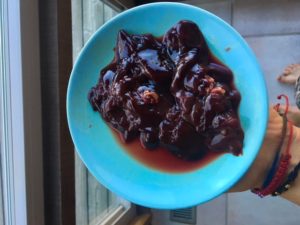
Unfortunately, like most people in modern Western society, I don’t have the palette for liver, so it is the ONLY food I eat regularly that I don’t enjoy eating. But that’s just proof of how vitally important this food is in my healing – that I’d be willing to eat it even though I hate it! It is THE superfood that I’d recommend everyone eat at least once or twice a week.
So what makes liver so wonderful? Quite simply, it contains more nutrients, gram for gram, than any other food. In summary, liver provides:
-An excellent source of high-quality protein
-Nature’s most concentrated source of vitamin A
-All the B vitamins in abundance, particularly vitamin B12
-One of our best sources of folic acid
-A highly usable form of iron
-Trace elements such as copper, zinc and chromium; liver is our best source of copper
-An unidentified anti-fatigue factor
-CoQ10, a nutrient that is especially important for cardio-vascular function
-A good source of purines, nitrogen-containing compounds that serve as precursors for DNA and RNA.
A popular objection to eating liver is the belief that the liver is a storage organ for toxins in the body. While it is true that one of the liver’s role is to neutralize toxins (such as drugs, chemical agents and poisons), it does not store these toxins. Toxins the body cannot eliminate are likely to accumulate in the body’s fatty tissues and nervous systems. On the other hand, the liver is a is a storage organ for many important nutrients (vitamins A, D, E, K, B12 and folic acid, and minerals such as copper and iron). These nutrients provide the body with some of the tools it needs to get rid of toxins.
The impact liver has had most on my health has been on it’s amazing ability to combat fatigue and give me engergy. For the millions of Americans with chronic fatigue, this is a really big deal. Also, most of us who have reactions to immunogenic proteins in foods might find it very freeing to consume a form of protein that actually LIFTS our energy! Usually it’s the opposite for anyone with compromised intestines. I tend to throw small portions of liver into larger meat dishes to hide the taste, I make frozen liver pills, and I’ll buy clean liver pate’s every chance I get! Still working on my own pate-making skills…
5. Sweet potatoes
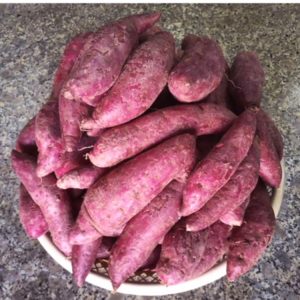
I’ve actually been cutting back on sweet potatoes lately, after spending the vast majority of my twenties eating them non-stop! Almost any food can become toxic if overeaten long-term – especially by an already compromised system. Something to remember if you’re like me and find a food you like and don’t react to then go crazy with it. After I removed most grains from my diet in the second half of my twenties, sweet potatoes became THE ultimate starch replacement. Despite clearly overdoing it, they truly did save my life for years!
They never stopped tasting good. Never stopped filling me up and providing my body with a more bio-available form of carbohydrate, as well as high in Vitamin C, calcium, folate, potassium and beta-carotene. They’re low-glycemic compared to regular white potatoes and are so versatile that I was actually able to eat the practically everyday for years without getting sick of them.
The few caveats to sweet potatoes are that they can cause digestive distress in folks with gut issues and reactions to FODMAPS in foods. Sweet potatoes also contain high amounts of oxalates, which may not bother many people, yet can cause a lot of chronic problems in others over time. And although they are low-glycemic in comparison to regular potatoes, they can still cause problems when eaten in abundance or on their own in folks with chronic blood-sugar issues. So, just keep in mind that they are not the carb panacea that I and many others treated them as for years.
6. Avocados
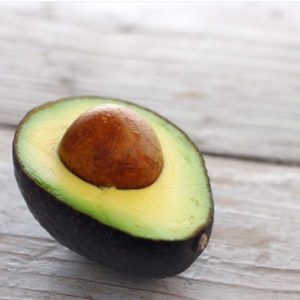
It’s hard to find a person who doesn’t like avocados! They’re out there, I’m sure, but they’re total freaks! Kidding. Not Kidding. Kidding.
Avocados have been one of my dietary staples for about half of my life. Growing up in California, it’s always been natural to have avocado on my deli sandwiches and in my breakfast at restaurants. While I was straining so hard to sustain my vegan and aspiring raw foodist diet, avocados were one of the core foods which kept me going.
Not only are they fucking delicious, they’re also a superfood and a great source of:
- Saturated fat in the form of oleic acid
- Amino acids
- Vitamin B6, C, E, and K
- Folate
- Pantothenic acid
- Niacin
- Riboflavin
- Potassium
- Copper
- Manganese
- and magnesium.
- An excellent source of carotenoids such as beta-carotene, alpha carotene, lutein, and contains a considerable amount of glutathione – our body’s main antioxidant!
I make salad dressing and sauces with them, put them in tacos, salads, and top of my homemade soups with them. And the thing that I love using them for the most is smoothies and dessert shakes. I always use avocado to make my smoothies extra creamy and filling. If you’re in CA, you’ve got it made in this department. If you’re in another state, the best I can recommend is that you aim to source your avos from the US instead of Mexico, as the nutrient-quality is better and the wages for avocado growers in the US are better.

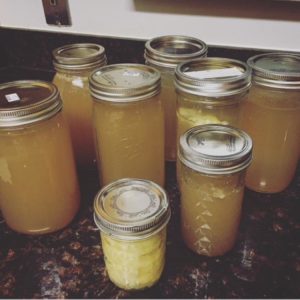





Recent Comments